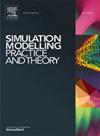机器学习辅助的微观公共交通仿真:两种耦合策略
IF 3.5
2区 计算机科学
Q2 COMPUTER SCIENCE, INTERDISCIPLINARY APPLICATIONS
引用次数: 0
摘要
对于公共交通运营商来说,评估公共交通(例如公交线路)的性能是一个重要问题。为了能够整合特定的本地行为,微观线路模拟(对每辆公交车进行日常建模)在精度和质量方面提供了实际的附加值。要进行更真实、更准确的模拟,就必须使用适当的参数。为了实现这一目标,可以使用在真实世界数据上训练的机器学习模型来为仿真模型提供信息和参数。为了解决这一科学问题,有必要确定如何有效地整合机器学习和仿真模型。本研究旨在利用各种策略将机器学习和微观仿真模型结合起来,评估它们的准确性和性能,并讨论各自的优缺点。本研究进行了一项涉及三条公交线路的案例研究,研究结果与真实世界的数据进行了验证,显示在线和离线策略都非常适合。离线策略具有最佳的模拟时间、良好的准确性以及充足的旅行时间和公交准点率,似乎在其他耦合策略中脱颖而出。本文章由计算机程序翻译,如有差异,请以英文原文为准。
Machine learning-assisted microscopic public transportation simulation: Two coupling strategies
Evaluating the performance of public transportation, such as bus lines for example, is a major issue for Public Transportation operators. To be able to integrate specific and local behaviors, microscopic line simulations, modeling each buses on a daily basis, provide actual added value in terms of precision and quality. Carrying out more realistic and accurate simulations requires the use of appropriate parameters. To achieve this, machine learning models trained on real-world data can be used to feed and parameterize simulation models. To address this scientific question, it is necessary to determine how to efficiently integrate machine learning and simulation models. This study aims to couple machine learning and microscopic simulation models using various strategies, evaluate their accuracy and performance and discuss the advantages and drawbacks of each. A case study involving three bus lines was conducted, with results validated against real-world data, showing a good fit for both online and offline strategies. With the best simulation time, good accuracy and adequate travel times and bus punctuality, an offline strategy seems to stand out from other coupling strategies.
求助全文
通过发布文献求助,成功后即可免费获取论文全文。
去求助
来源期刊

Simulation Modelling Practice and Theory
工程技术-计算机:跨学科应用
CiteScore
9.80
自引率
4.80%
发文量
142
审稿时长
21 days
期刊介绍:
The journal Simulation Modelling Practice and Theory provides a forum for original, high-quality papers dealing with any aspect of systems simulation and modelling.
The journal aims at being a reference and a powerful tool to all those professionally active and/or interested in the methods and applications of simulation. Submitted papers will be peer reviewed and must significantly contribute to modelling and simulation in general or use modelling and simulation in application areas.
Paper submission is solicited on:
• theoretical aspects of modelling and simulation including formal modelling, model-checking, random number generators, sensitivity analysis, variance reduction techniques, experimental design, meta-modelling, methods and algorithms for validation and verification, selection and comparison procedures etc.;
• methodology and application of modelling and simulation in any area, including computer systems, networks, real-time and embedded systems, mobile and intelligent agents, manufacturing and transportation systems, management, engineering, biomedical engineering, economics, ecology and environment, education, transaction handling, etc.;
• simulation languages and environments including those, specific to distributed computing, grid computing, high performance computers or computer networks, etc.;
• distributed and real-time simulation, simulation interoperability;
• tools for high performance computing simulation, including dedicated architectures and parallel computing.
 求助内容:
求助内容: 应助结果提醒方式:
应助结果提醒方式:


